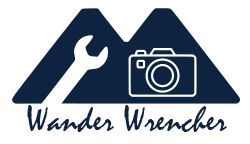The closing chapter of a restoration project of a Ford Escort IV (ALF), which took close to two years to complete, was to partake in the Budapest Rally.
What is the Budapest rally?
The closing chapter of a restoration project of a Ford Escort IV (ALF) which took two years would be completing Europe’s most colorful ‘rally’: The Budapest Rally; a roadtrip among the most scenic routes leaving from Brussels to Budapest in a week long trip while crossing marvelous mountain passes such as the Flüelapass, the Stelviopass and the Klausenpass. You’ll be crossing into nine different countries and you’re bound to come back with some stories to tell. Partaking in this event will take you to some well known places such as the Balaton lake or Plitvice and some lesser known places such as the Željava Air Base. Daily challenges will put a smile on your face (and whoever is looking) whether you succeed or not. Even if you’re not a petrol head you’ll like this scenic trip. Unfortunately for us, this adventure came to an early end after a failed six-months old bearing took out the hub and spindle. Here’s a handful of lessons we learned from our breakdown and other’s to do better the next time.
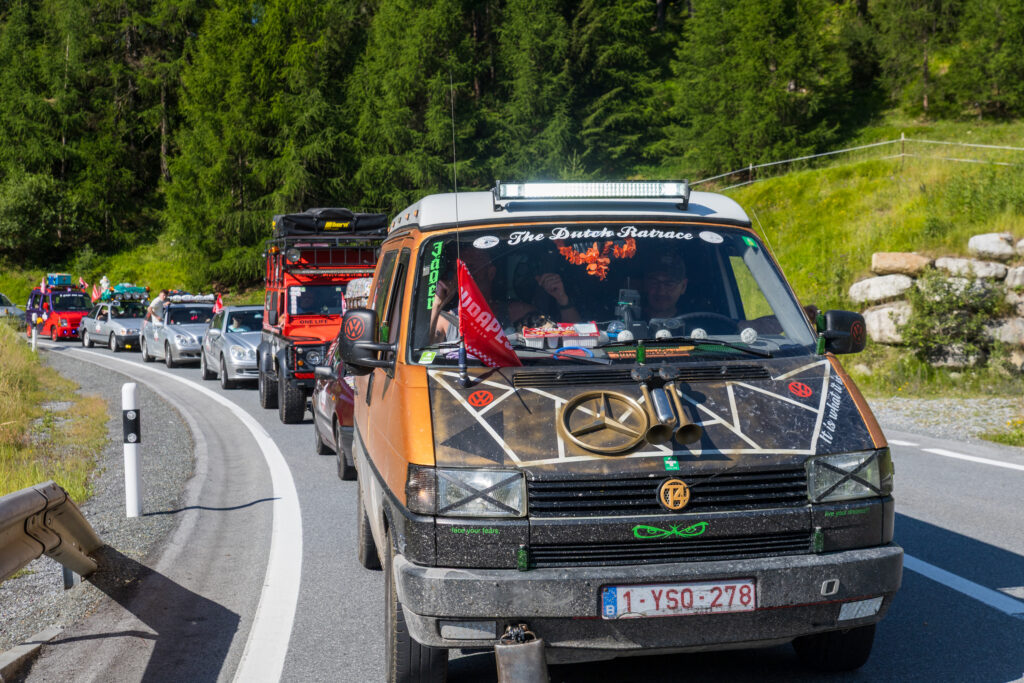
Table of Contents
Cooling
The biggest issue on the trip was for sure cooling, a heatwave in Southern Europe coincided with our arrival. Safe from the more modern cars, most of the old-timers had to stand on the side of the road for quite some time to let the engines cool down from an intense climb on a hot summer’s day. It didn’t take long for people to start improvising: driving with the bonnet opened on a crack to increase air flow seemed to help some of the heavier sedans. Another trick was to remove part of the bumper and increase air-flow to the radiator, which led to some interesting sightings. The most creative solution we saw was re-routing the windscreen-sprinkler system to spray on the radiator – great thinking.
We opted to bridge the switch so that the ventilator on the radiator was on full-time, this was enough to let the coolant cool down on flatter bits of the road well below the usual cut-off point of the fan so we had some buffer when tackling the steeper bits. It also had the added benefit we could just keep on the fan with the engine off to cool it more efficiently while we took a photo-op break or simply enjoyed the view. At the worst part of the day the tiny 1.4 carbureted CVH-engine still produced more heat on the steep climbs than could be dissipated through the radiator. To help the radiator we – and many others – turned the interior heating full blast – thank goodness the roof could go down.
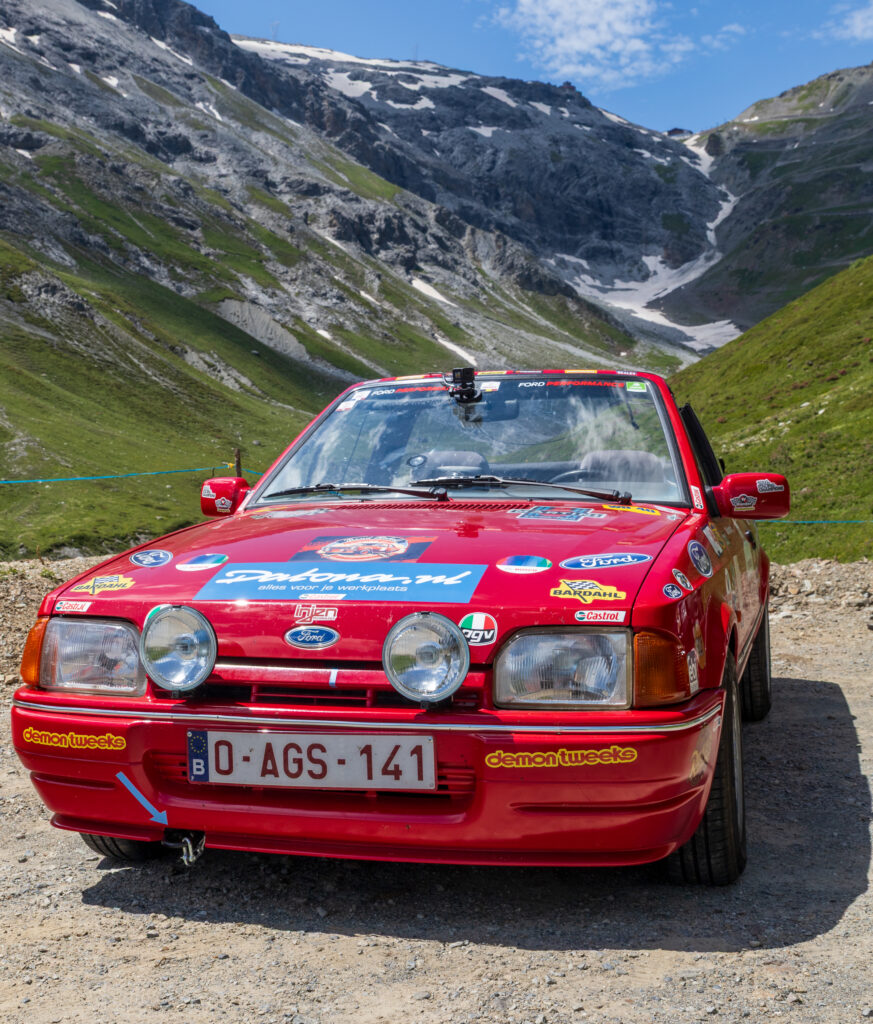
This seemed to help even during the hottest moments of the day, and it made me wonder if simply adding an additional radiator (to increase the heat-exchange surface) would get us out of pinch for a next edition. I’ll definitely be investigating this as an option for the next Stelvio Climb. It also made me wonder if the CVH 1.6 with injection used in the XR3i has better cooling performance than the one coupled to my carbureted 1.4 engine.
Wheels and tires
When starting my mechanics classes a few years ago, the very first module we got was about tires – and there’s a good reason for that. To paraphrase the teacher “The only thing keeping your ass safely on the road are your tires. So you better treat them well.” The car we travelled with had new Hankook tires all round and one single spare tire in the boot. On top of that we carried a tire repair kit and a 12V-chargeable mobile air compressor. The spare tire will get you out of a pinch and the tire repair kit hardly takes up any space, with this combination you can drive immediately after replacing the faulty tire and patch the tire at a more convenient moment or in the safety of a designated parking space rather than the side of a narrow pass.
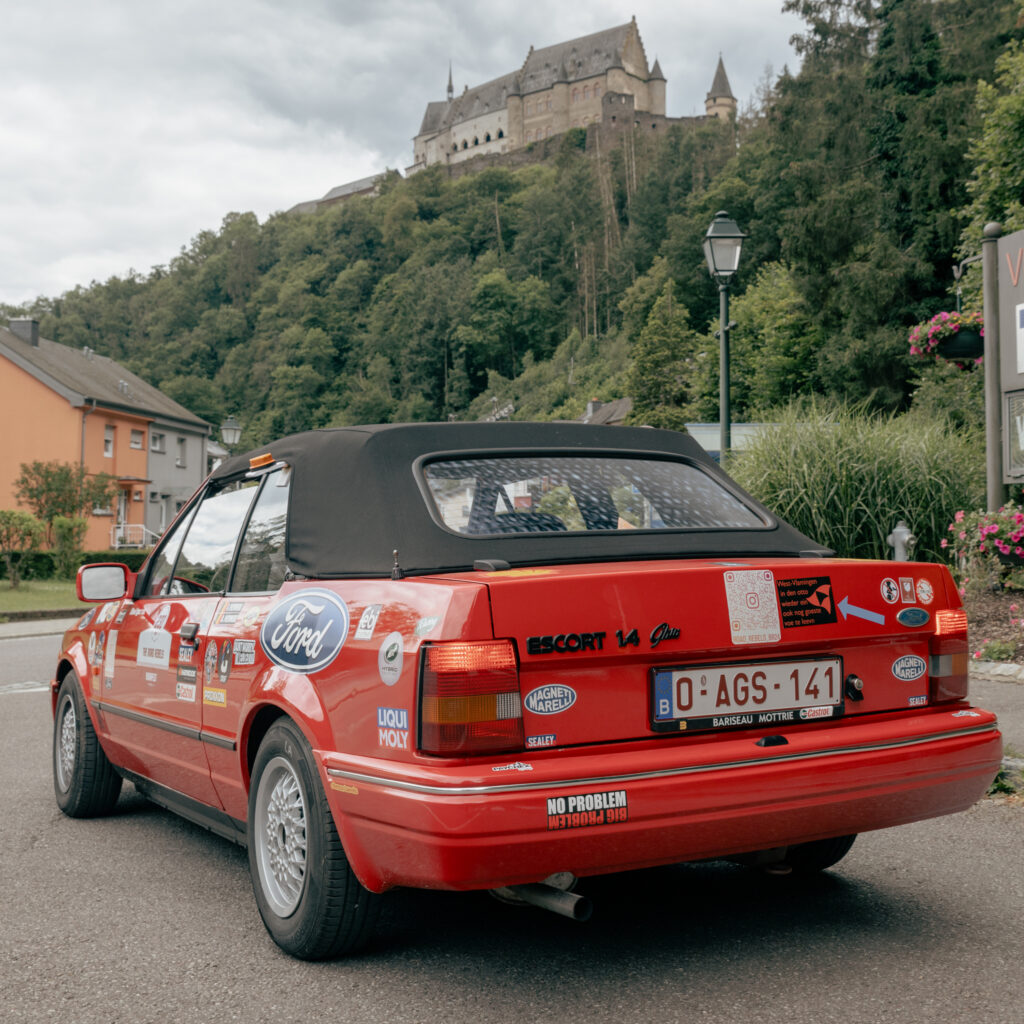
The only thing keeping your ass safely on the road are your tires. So you better treat them well.
We never came to the point where we even needed to touch the spare tire. But others were less fortunate. My key takeaways learned from some interventions here are:
- Anti-theft bolts == bolts of misery: Anti-theft bolts are bolts or nuts holding the rim to the brake rotor which can only be undone with a special key. Just leave these anti-theft bolts home and replace them with standard bolts, or if you really want to keep them on, make sure you have the key for them with you. Double check that all bolts you use have the same sized head, or carry all necessary sockets with you. Sometimes the bolts are quite deep in the alloy, make sure you hava an extension or extra long socket if that’s the case.
- Jacks: Take a jack that’s safe to use, even if it’s just for a tire change. The Ford came with a very compact, but not so safe emergency jack. We replaced it by taking a regular scissor jack, which was more stable. Though I would never even think of using this jack to do work underneath the car.
- Tire pressure and tire wear: check the owner’s manual of your car in advance: how much pressure should go in each tire and double check the load conditions to avoid uneven wear of your tire. A car that’s loaded heavily needs more tire pressure than a car with only a single person in. Don’t forget to check the spare tire too. Gauges in the sidewall or metal wires sticking out of your tire are a big nono, check the inside and outside and consider replacing them before leaving.
- Rims: If you have the luxury of choice; pick alloys which have plenty of ventilation. I managed to get my hands on a gorgeous set of alloys formerly used on a Ford Fiesta XR2i (Type: ). If you don’t have the luxury of choice, just avoid doing one thing: Do not wrap the rims shut; this will restrict airflow too much.
Fluids
Brakes: a liter of brake fluid will set you back a tenner, boiling brake fluid may cost you your car. Be smart about this and replace the fluid before you go. Once opened brake fluid starts to attract moisture out of the air, this lowers the boiling point of the liquid. If it becomes too low, the collected water in the brake fluid starts boiling, at this point there’s compressible gas in the system and you will experience a phenomenon known as brake fade.
Just putting in fresh fluid won’t prevent brake fade completely, but it helps a lot. You’ll still need to use engine braking when going downhill to prevent overheating (and warping) the brake discs or burning the pads.
Steering fluid: The Escort doesn’t have power steering, so this issue never popped up, but on the Stelvio pass multiple cars suffered from boiled over steering fluid. This happens because you go over multiple hair-pin corners shortly after each other. The pump pushing the hydraulic fluid around has to work hard and put pressure on all of the fluid which in turn gets warm (We’re assuming the pump is in perfect condition). Furthermore glycol based steering fluid is hygroscopic, just like brake fluid, it attracts water from the air lowering the boiling point. To try and prevent this: buy some cheap fluid to flush the system of any debris and then fill it up with a reputable brand before you set off. Look for the lines that are used by the power steering pump and make sure they get some airflow. Some cars even use a small radiator to cool the power steering circuit, make sure this is unobstructed.
- Coolant: Climbing mountain passes on a hot day with a heavily packed old-timer means your cooling system will get hot – really hot. Anticipate a bit on this by making sure you coolant cap is still good and can vent-off excess pressure before overpressure blows a coolant line or your radiator. Flush the system if you think there’s a problem somewhere and make sure you have enough coolant in the system. It will not hurt you to carry a few spare liters, just make sure that you don’t mix different types of coolant. If you ever find yourself in trouble and need to refill the coolant system completely, make sure you know how to do that, a rule of thumb is to try and make sure your coolant cap is the highest point in the cooling circuit. Sometimes a strategically placed rock under a wheel is enough to do just that. Other times you’ll find yourself looking for a special funnel. Check your coolant level every day before setting off on a cold engine – then the system holds no pressure.
- Oil: this is a no-brainer; have some extra oil available. The last thing you want is to spin an enginebearing because you ran low on oil.
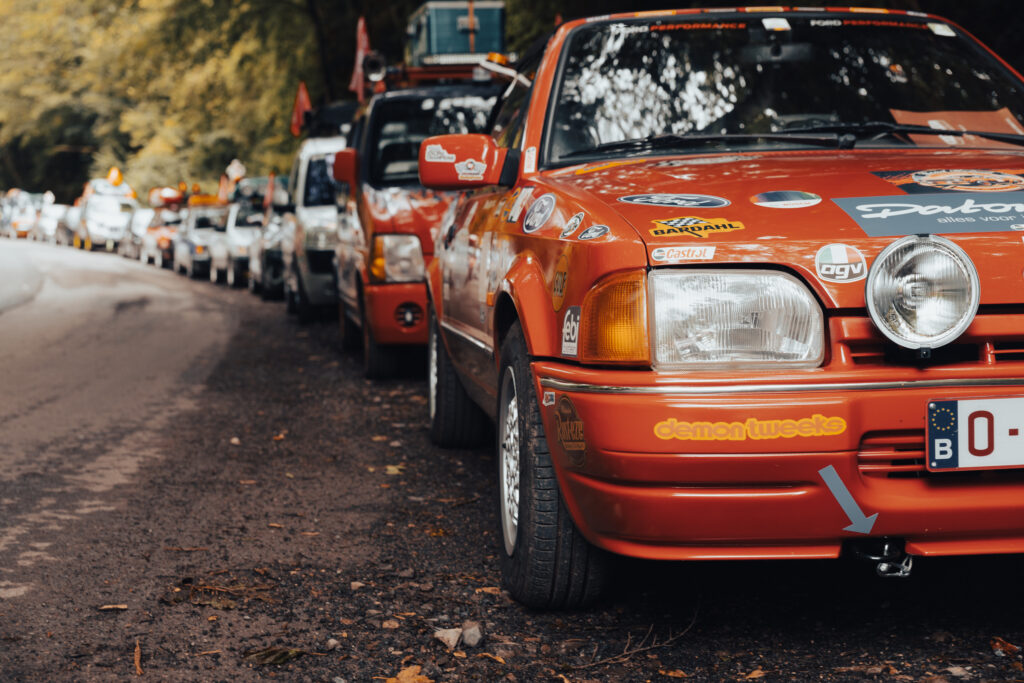
Electricity
You’ll always carry some electrical equipment on your trip; phones, GPS, camera’s… they all need to be charged somehow. I added a few extra USB chargers connected to the 15-wire (Bosch number for “power after ignition”) to keep all electronics charged. It’s a good idea to take some time planning which electronics you’ll take and how to charge them as not all USB-chargers are made equal. There are different charging standards being used by different pieces of electronics. Sometimes a normal USB 2.0 will suffice to charge your device. Other times you’ll be required to have QuickCharge or even a port with PowerDelivery. The same is true for the cables you take with you, not all cables are compatible with USB-PD.
Check the compatibility of the devices you want to take, then get whatever you need. A lot of these after market USB chargers come with glass fuses, cut them out and replace them with a normal fuse with equivalent current rating – it’s much easier to find automotive fuses than glass fuses. The USB-chargers were split in multiple circuits, each with their own relays, fuses and wiring which were all housed in a separate fusebox. The original wiring could be left untouched safe for a single 15-wire which was used to prevent draining the battery with the ignition turned off.
When driving the engine, a belt drives the alternator. Before you leave make sure the alternator is good by testing the charge system under load: turn on all the lights, the rear window heating, whatever big consumers you can find and see if the alternator puts enough power on the battery to keep it topped up on your roadtrip. If you ever had liquids leaking on your alternator such as fuel (especially Diesel), make sure to replace the carbon brushes before leaving.

Tools and spares
Here you need to find a balance between what to take with you and what’s convenient. We had limited space in our Escort ALF so we had to make choices. One big toolbox, a half inch and quarter inch socket set and torque wrenches was all we took. taking spare parts is tricky; it’s hard to predict which part may fail – and frankly I’d have never predicted a new bearing would fail taking out the hub and spindle. We did not take axle stands with us, we only had a small jack. In hindsight small 3-ton rated axle stands would’ve been helpful to diagnose the cause of our breakdown more precisely and properly inspect each component, but without the spare parts it wouldn’t have gotten us any further.
We managed to do all our road-side fixes without the need for more tools, but without spares you’ll often find yourself improvising. We most often used zipties to temporarily hold stuff in place till a new part could be sourced, duct tape to close of teared hoses and vulcanizing tape for applications that have to deal with pressure and heat. It’s never a bad idea to have some spare hose clamps with you either. And just in case there’s a hose with a big diameter you might want to carry a few metal tie-wraps for heavy duty applications such as inter-cooler lines.
Insurance
I set off with a mindset “anything after the Stelvio is a bonus”, I didn’t mean it as literally as it went, but some things in life are just out of your control. For stuff like that it’s nice to have a good insurance which includes roadside assistance. Before embarking on a trip like this go and compare a few different quotes and explain the kind of travel you want to do. An insurance policy will often make the difference between totaled (economically not worth to fix) or damaged and fixable. Getting a rental car to continue your trip will often depend on this. In my case, the rental car would only be an option if the car would’ve been totaled.
In stead we got the option to extend our trip while we waited for a difficult to source part. This would’ve interfered with a planned flight shortly after my return. The other option was repatriation home. We opted for the latter. It’s never fun to quit a trip like this early, but at least we could rest assured that my little problem child would be recovered by a professional firm with all expenses covered by insurance. Often times I get a second insurance for a few days from Heymondo – I didn’t think of it this time but in hindsight it might’ve been useful.
I’d wish to report that repatriation was uneventful, alas it wasn’t. It got delivered home without being announced by the insurance; it had parts missing and worst, it had a rather deep paint scratch and damage to the freshly painted front bumper from one of the towing vehicles. So my last tip is to always take pictures or just walk round the car and take a video before handing it over to anyone. I’m lucky to report that the repatriation company owed up to both issues and helped look for an acceptable solution.
Meet me Frédéric, the ex-twenty-something petrolhead navigating life in the little town of Leuven (and beyond!) while hurtling through space on this beautiful rock we call home. By day, I work magic as a coffee-into-code convertor, but when the weekend rolls around, you'll find me scaling walls (until gravity inevitably says `nope`), travelling into wonderland, and generally living life in carpe-diem-mode. Don't be surprised if you spot me snapping pics along the way - there's always a trusty camera somewhere! So buckle up, put the pedal to the metal, and come along for the ride with me!
image sources
- Budapestrally – 15 July 2024 – 0146: © https://blog.photowski.be | All Rights Reserved
- Budapestrally – 15 July 2024 – 0151: © https://blog.photowski.be | All Rights Reserved
- Budapestrally – 13 July 2024 – 0047: © https://blog.photowski.be | All Rights Reserved
- Budapestrally – 13 July 2024 – 0020: © https://blog.photowski.be | All Rights Reserved
- Budapestrally – 13 July 2024 – 0091: © https://blog.photowski.be | All Rights Reserved
